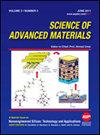新型抗菌氧化锌纳米棒的绿色合成
IF 0.9
4区 材料科学
引用次数: 0
摘要
氧化锌纳米颗粒(ZnO)越来越多地用于诊断和预防各种人类感染和疾病。这些纳米颗粒的多功能性质以及低毒性和可生物降解性等特点,使它们能够在生物医学、食品和补充剂行业、治疗学和生物传感器等一系列产品和应用中使用。氧化锌具有仿生特性,可用于生物医学应用,包括用作现有抗生素的替代品。本研究讨论了一种简单、经济、环境可持续的以蛋清或白蛋白为原料合成ZnO纳米棒的技术。采用x射线衍射(XRD)和选择面积电子衍射(SAED)技术测定了工程纳米晶体的单相性质。采用透射电镜(TEM)和场发射扫描电镜(FESEM)研究了ZnO纳米棒的形貌。合成的氧化锌纳米棒的直径在20 ~ 30 nm之间。采用拉曼光谱和红外光谱分析了纤锌矿ZnO的晶体结构,采用BET (brunauer - emmet - teller)表面积法分析了纤锌矿ZnO的比表面积(12.8 m2 /g)。在不需要人工紫外线激活的情况下,用革兰氏阳性和革兰氏阴性菌株对氧化锌纳米棒的抗菌能力进行了测试。研究结果表明,社区和医院环境中存在的不同致病细菌对氧化锌纳米棒的抗菌活性有不同的反应。随着纳米棒粉浓度的增加,细菌存活率下降,抗菌活性增强。结果表明,与其他革兰氏阴性菌和阳性菌相比,革兰氏阴性菌铜绿假单胞菌的氧化锌纳米棒抑菌活性最高。绿色环保的氧化锌纳米粒子合成技术可以制备出重要的多功能纳米材料,这些材料具有良好的抗菌性能,可以开发出多种耐药细菌的药物。本文章由计算机程序翻译,如有差异,请以英文原文为准。
Green Synthesis of Novel Antimicrobial ZnO Nanorods
Zinc oxide (ZnO) nanoparticles (NPs) are increasingly used in the diagnosis and prevention of various human infections and diseases. The multi-functional nature of these nanoparticles together with characteristics such as low toxicity and biodegradability, allow their use in a slew of products and applications ranging from biomedical, food and supplement industries, therapeutics and biosensors. ZnO exhibits biomimetic properties enabling biomedical applications, including use as alternatives to pre-existing antibiotics. This study discusses a simple, cost-effective and environmentally sustainable technique for the synthesis of crystalline ZnO nanorods from egg-white or albumin. Single phase nature of the of the engineered nanocrystals was determined using X-ray diffraction (XRD) and selected area electron diffraction (SAED) technique. The morphology of the ZnO nanorods was studied using transmission electron microscopy (TEM) and field emission scanning electron microscopy (FESEM). The diameter of synthesized ZnO nanorods was determined to be in the range of 20–30 nm. The crystal structure of wurtzite ZnO was discovered by the use of Raman, FTIR, while the surface area (12.8 m 2 /g) was analyzed by using Brunauer-Emmett-Teller (BET) surface area study. Both gram-positive and gram-negative bacterial strains were used to test the ZnO nanorods’ antibacterial abilities without the need of artificial UV activation. Findings showed that different disease-causing bacteria present in community and hospital settings respond differently to ZnO nanorods’ antibacterial activity. When the concentration of nanorods powder increased, the ratio of bacterial survival dropped, showing an increase in antibacterial activity. The gram-negative strain Pseudomonas aeruginosa was shown to have the maximum antibacterial activity of the ZnO nanorods as compared to other gram-negative and positive bacteria. Eco-friendly and green synthesis of ZnO NPs produce vital multifunctional nanomaterials which possess promising antibacterial properties with more extensive studies may develop drugs for multidrug resistance bacteria.
求助全文
通过发布文献求助,成功后即可免费获取论文全文。
去求助
来源期刊

Science of Advanced Materials
NANOSCIENCE & NANOTECHNOLOGY-MATERIALS SCIENCE, MULTIDISCIPLINARY
自引率
11.10%
发文量
98
审稿时长
4.4 months
 求助内容:
求助内容: 应助结果提醒方式:
应助结果提醒方式:


